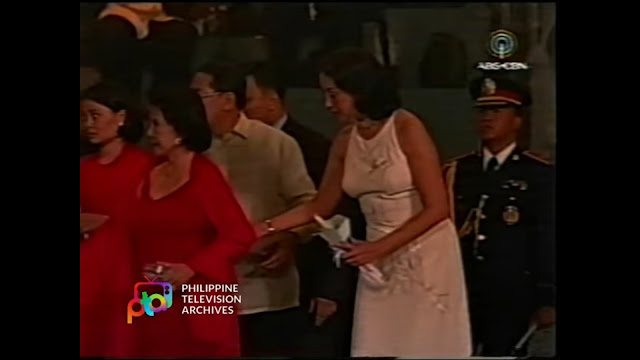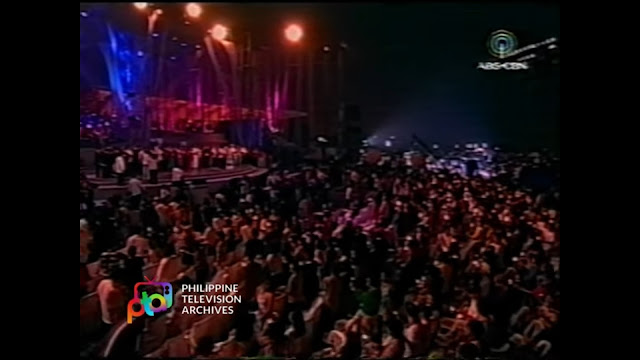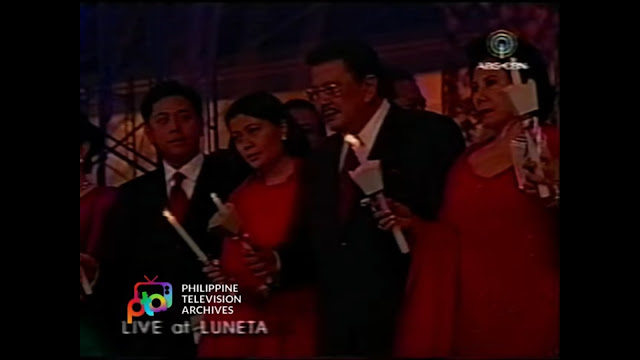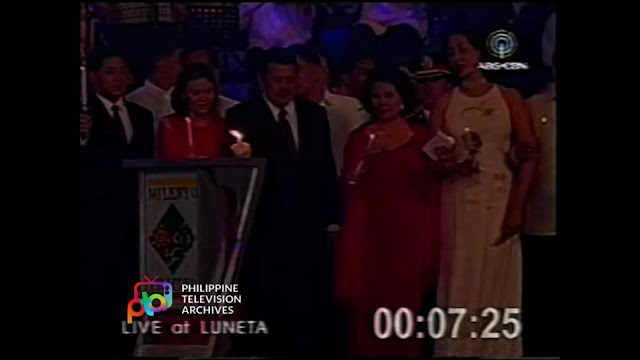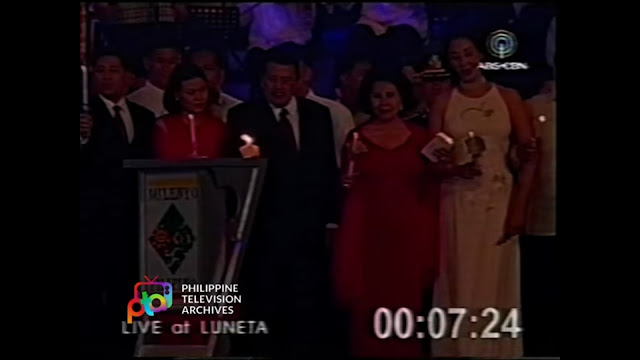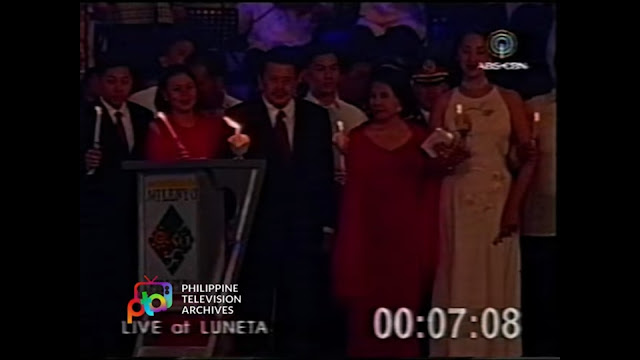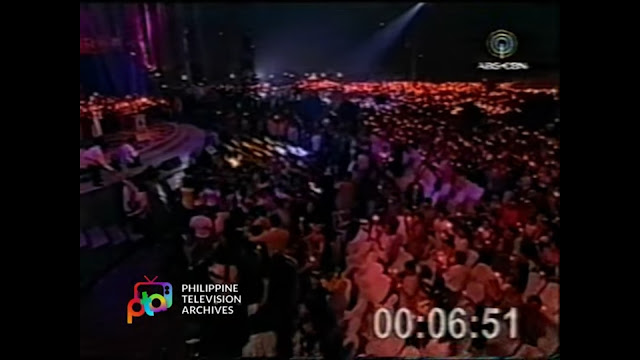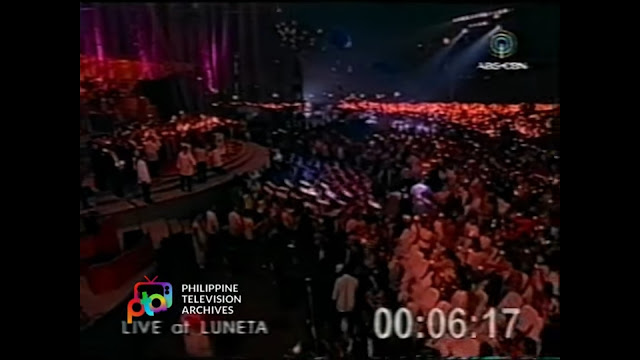Chairmanship of Fernando Lopez (1975-1993)
First term
Succession
Second decade as the chairman
Third decade and final years
"The Pia Cayetano-Paolo Abrera Affair and re-run of Ninoy Aquino assassination (Companero y Companera)"
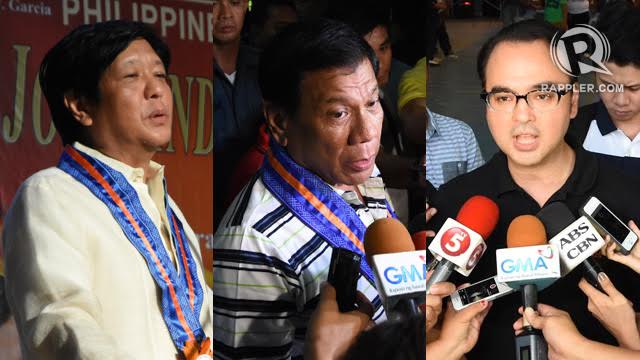 |
| Losing vice-presidential candidates Senator Ferdinand Marcos, Jr. (left) and Alan Peter Cayetano (right), now President Rodrigo Duterte (center) |
The 2007 Southeast Asian Games in Nakhon Ratchasima, Thailand
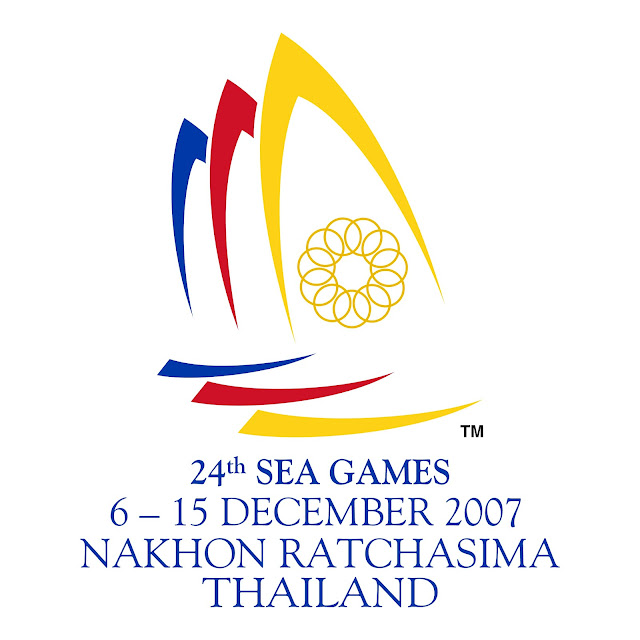
It feels like 1995 for GMA, when the network was branded as a "rainbow satellite" and its slogan was "Where You Belong." GMA was the official network of Pope John Paul II's visit to the 10th World Youth Day in Manila, Philippines, from January 12 to 16, 1995.


 |
| GMA: The Official Network banner for the 2007 SEA Games |
.jpg)
 |
| Arnold Clavio and Jessica Soho anchored the papal visit coverage in January 1995 and January 2015. |
.jpg) |
| GMA's 1992 logo without the words "Rainbow Satellite" |
- GMA-7 Manila
- TV-7 Batanes
- TV-5 Laoag
- TV-48 Vigan
- TV-7 Abra
- TV-11 La Union
- TV-7 Tuguegarao
- TV-13 Aparri
- TV-30 Apayao
- TV-9 Kalinga
- TV-5 Mountain Province
- TV-7 Santiago, Isabela
- TV-13 Cauayan, Isabela
- TV-21 Ilagan, Isabela
- TV-5 Bayombong
- TV-12 Quirino
- TV-10 Baguio
- TV-10 Dagupan
- TV-5 Baler
- TV-7 Cabanatuan
- TV-35 Llanera
- TV-10 Olongapo
- TV-5 Botolan
- TV-14 Iba
- TV-10 Pampanga
- TV-48 Tarlac
- TV-3 Bagac
- TV-27 Balanga
- TV-30 Angat
- TV-46 Malolos
- TV-26 Obando
- TV-12 Batangas
- TV-26 Tagaytay
- TV-15 Lucena
- TV-48 Patnanungan
- TV-23 Calamba
- TV-26 San Pablo
- TV-44 Jalajala, Rizal
- TV-13 Occidental Mindoro
- TV-11 Bongabong, Oriental Mindoro
- TV-13 Boac, Marinduque
- TV-5 Santa Cruz, Marinduque
- TV-10 Torrijos, Marinduque
- TV-12 Puerto Princesa, Palawan
- TV-6 Brooke’s Point, Palawan
- TV-8 Coron, Palawan
- TV-17 Cuyo, Palawan
- TV-13 Balabac, Palawan
- TV-7 Romblon
- TV-7 Masbate
- TV-7 Naga
- TV-8 Malilipot
- TV-12 Legazpi
- TV-13 Catanduanes
- TV-2 Sorsogon
- TV-8 Daet
- TV-5 Calbayog
- TV-9 Catarman
- TV-11 Catubig
- TV-13 Catbalogan
- TV-8 Borongan
- TV-35 Naval, Biliran
- TV-10 Tacloban
- TV-12 Ormoc
- TV-10 Capoocan, Leyte
- TV-12 Isabel, Leyte
- TV-44 Maasin
- TV-2 Kalibo
- TV-35 Malay, Aklan
- TV-12 San Jose, Antique
- TV-35 Culasi, Antique
- TV-5 Roxas
- TV-6 Iloilo
- TV-9 Guimaras
- TV-13 Bacolod
- TV-23 Bais
- TV-5 Cadiz
- TV-30 Murcia, Negros Occidental
- TV-7 Cebu
- TV-26 Bogo
- TV-11 Samboan
- TV-11 Bohol
- TV-5 Dumaguete
- TV-11 Guihulngan
- TV-48 Siquijor
- TV-10 Sipalay
- TV-41 Mambajao
- TV-35 Cagayan de Oro
- TV-30 Gingoog
- TV-12 Bukidnon
- TV-4 Dipolog
- TV-34 Oroquieta
- TV-5 Ozamiz
- TV-3 Pagadian
- TV-11 Iligan
- TV-26 Butuan
- TV-10 Surigao
- TV-2 Tandag
- TV-35 Bislig
- TV-3 Prosperidad, Agusan del Sur
- TV-5 Davao
- TV-44 Tagum
- TV-35 Panabo
- TV-3 Digos
- TV-13 Malita
- TV-21 Baganga
- TV-48 Mati
- TV-30 Nabunturan
- TV-6 Kidapawan
- TV-12 Cotabato
- TV-13 Marawi
- TV-8 General Santos
- TV-13 Koronadal
- TV-30 Tacurong
- TV-2 Ipil
- TV-30 Imelda, Zamboanga Sibugay
- TV-9 Zamboanga
- TV-12 Jolo
- TV-44 Tawi-Tawi
_page-0002.jpg)
_page-0003.jpg)










 |
| Noontime habits. Eat Bulaga! hosts Tito Sotto, Vic Sotto, and Joey de Leon, the Sexbomb dancers, EB! directors Bert de Leon and Poochie Rivera, and EB! producers Grace Esquillon and Malou Choa-Fagar. Feature from YES! magazine, 2003 |
 |
| Eat Bulaga! hosts Tito Sotto, Vic Sotto and Joey de Leon. |


 |
| Eat Bulaga! dabarkads |
 |
| EAT BULAGA! 23rd anniversary photoshoot with then-hosts: Paolo Ballesteros, Toni Gonzaga, Janno Gibbs, Ruby Rodriguez, Leila Kuzma, Anjo Yllana, Jimmy Santos, Joey de Leon, Vic Sotto, Jose Manalo, Wally Bayola, Toni Rose Gayda, Nadine Schmidt, Gladys Guevarra, Francis M. Not in photo: Allan K, who was in Australia at the time of the shoot. Photographed by Rene Mejia for YES! Magazine, 2002 |
 |
| Alden Richards and Maine Mendoza |







Luzon
- ABS-CBN 2 Manila
- TV-7 Laoag
- TV-11 Vigan
- TV-40 La Union
- TV-32 Dagupan
- TV-46 Alaminos
- TV-11 Abra
- TV-3 Baguio
- TV-11 Mountain Province
- TV-11 Batanes
- TV-3 Tuguegarao
- TV-9 Aparri
- TV-2 Isabela
- TV-11 Bayombong
- TV-13 Cabarroguis
- TV-6 Iba
- TV-13 Botolan
- TV-12 Olongapo
- TV-22 Bataan
- TV-46 Pampanga
- TV-32 Tarlac
- TV-34 Bulacan
- TV-16 Malolos
- TV-12 Meycauayan
- TV-19 Obando
- TV-32 Cabanatuan
- TV-22 Baler
- TV-40 Rizal
- TV-6 Calamba
- TV-46 San Pablo
- TV-32 Tagaytay
- TV-10 Batangas
- TV-38 Lipa
- TV-2 Lucena
- TV-11 Occidental Mindoro
- TV-21 Calapan
- TV-7 Puerto Princesa
- TV-10 Sofronio Española, Palawan
- TV-12 Taytay, Palawan
- TV-19 Brooke’s Point, Palawan
- TV-5 Coron, Palawan
- TV-21 Cuyo, Palawan
- TV-7 Balabac, Palawan
- TV-52 Kalayaan, Palawan
- TV-11 Roxas, Palawan
- TV-12 Taytay, Palawan
- TV-9 Romblon
- TV-10 Daet
- TV-11 Naga
- TV-8 Iriga
- TV-7 Catanduanes
- TV-4 Legazpi
- TV-10 Tabaco
- TV-10 Masbate
- TV-7 Sorsogon
Visayas
- TV-10 Iloilo
- TV-9 Kalibo
- TV-21 Boracay
- TV-44 Antique
- TV-21 Roxas
- TV-4 Bacolod
- TV-8 Bais
- TV-40 Murcia
- TV-7 Cadiz
- TV-26 Sipalay
- TV-3 Cebu
- TV-2 Toledo, Cebu
- TV-13 Barili, Cebu
- TV-7 Siquijor
- TV-9 Bohol
- TV-12 Dumaguete
- TV-13 Biliran
- TV-2 Tacloban
- TV-5 Catarman
- TV-7 Catbalogan
- TV-10 Calbayog
- TV-38 Borongan
Mindanao
- TV-42 Dipolog
- TV-11 Pagadian
- TV-5 Ipil
- TV-3 Zamboanga
- TV-2 Cagayan de Oro
- TV-47 Mambajao
- TV-2 Malaybalay
- TV-4 Iligan
- TV-7 Ozamiz
- TV-2 Marawi
- TV-11 Butuan
- TV-12 Surigao
- TV-26 Tandag
- TV-2 Bislig
- TV-5 Agusan del Sur
- TV-4 Davao
- TV-24 Mati
- TV-23 Baganga
- TV-11 Malita
- TV-50 Tagum
- TV-46 Nabunturan
- TV-3 General Santos
- TV-4 Koronadal
- TV-7 Alabel
- TV-4 Kidapawan
- TV-5 Cotabato
- TV-10 Jolo
- TV-42 Tawi-Tawi
- Studio 23 Manila
- TV-30 Baguio
- TV-36 Abra
- TV-36 Mountain Province
- TV-30 Laoag
- TV-30 Vigan
- TV-38 La Union
- TV-36 Dagupan
- TV-23 Batanes
- TV-23 Tuguegarao
- TV-23 Isabela
- TV-23 Bayombong, Nueva Vizcaya
- TV-36 Baler, Aurora
- TV-23 Botolan, Zambales
- TV-30 Cabanatuan, Nueva Ecija
- TV-30 Tarlac
- TV-24 Olongapo
- TV-24 Pampanga
- TV-24 San Miguel, Bulacan
- TV-36 Batangas
- TV-36 San Pablo, Laguna
- TV-36 Lucena
- TV-36 Jalajala, Rizal
- TV-36 Occidental Mindoro
- TV-23 Puerto Princesa, Palawan
- TV-23 Daet, Camarines Norte
- TV-24 Naga
- TV-23 Legazpi
- TV-49 Sorsogon
- TV-23 Kalibo
- TV-29 Roxas
- TV-38 Iloilo
- TV-22 Bacolod
- TV-24 Dumaguete
- TV-23 Cebu
- TV-40 Bohol
- TV-24 Tacloban
- TV-24 Calbayog
- TV-31 Catbalogan
- TV-23 Zamboanga
- TV-36 Dipolog
- TV-23 Pagadian
- TV-23 Cagayan de Oro
- TV-23 Ozamiz
- TV-26 Iligan
- TV-23 Bukidnon
- TV-21 Davao
- TV-36 Mati
- TV-36 General Santos
- TV-26 Kidapawan
- TV-24 Koronadal
- TV-22 Butuan
- TV-25 Agusan del Sur
- TV-23 Surigao
- TV-23 Cotabato
- TV-22 Marawi
- TV-24 Jolo
- TV-36 Tawi-Tawi
- DZMM 630 kHz Mega Manila
- 1008 kHz Laoag
- 837 kHz Vigan
- 828 kHz La Union
- 1377 kHz Dagupan
- 981 kHz Alaminos
- 675 kHz Bani, Pangasinan
- 621 kHz Urdaneta
- 693 kHz Bolinao, Pangasinan
- 1215 kHz Baguio
- 657 kHz Bontoc
- 612 kHz Tabuk
- 594 kHz Batanes
- 720 kHz Aparri
- 855 kHz Tuguegarao
- 828 kHz Isabela
- 89.3 MHz Bayombong
- 1188 kHz Baler, Aurora
- 729 kHz Cabanatuan
- 1368 kHz Tarlac
- 1512 kHz Olongapo
- 1251 kHz Balanga
- 93.3 MHz Pampanga
- 95.1 MHz Calamba
- 1197 kHz San Pablo
- 1080 kHz Batangas
- 639 kHz Lucena
- 855 kHz Calapan
- 612 kHz Taytay, Palawan
- 765 kHz Puerto Princesa, Palawan
- 864 kHz Daet
- 1359 kHz Naga
- 756 kHz Iriga
- 90.1 MHz Virac
- 684 kHz Legazpi
- 1125 kHz Sorsogon
- 783 kHz Masbate
- 684 kHz San Jose, Antique
- 801 kHz Kalibo
- 945 kHz Roxas
- 1494 kHz Iloilo
- 666 kHz Bacolod
- 1017 kHz Sagay
- 95.7 MHz Guihulngan
- 1206 kHz Dumaguete
- 1512 kHz Cebu
- 666 kHz Bohol
- 882 kHz Maasin
- 1098 kHz Sogod
- 918 kHz Baybay
- 954 kHz Tacloban
- 1476 kHz Calbayog
- 1188 kHz Catbalogan
- 792 kHz Catarman
- 91.3 MHz Oroquieta
- 106.7 MHz Ozamiz
- 1557 KHz Marawi
- 1026 kHz Iligan
- 990 kHz Cagayan de Oro
- 621 kHz Malaybalay
- 1206 kHz Butuan
- 864 kHz Surigao
- 1044 kHz Tagum
- 1296 kHz Davao
- 1233 kHz Digos
- 1269 kHz General Santos
- 864 kHz Koronadal
- 100.1 MHz Kidapawan
- 1179 kHz Cotabato
- 1332 kHz Zamboanga
- 765 kHz Jolo
- 1017 kHz Tawi-Tawi
- DWRR 101.9 Mega Manila
- DWEL 95.5 Laoag
- DZVC 96.1 Vigan
- DWTL 90.3 La Union
- DWEC 97.3 Dagupan
- DZRR 103.1 Baguio
- 102.9 Bangued
- DZTU 100.5 Tuguegarao
- DWBA 91.3 Isabela
- DWFE 105.7 Cauayan
- 105.7 Bayombong
- 103.3 Cabarroguis
- DWZT 100.7 Olongapo
- DWNV 88.5 Pampanga
- DZLS 107.1 Tarlac
- 100.5 Baler
- DWRS 102.5 Tagaytay
- 104.7 Calamba
- DWUD 92.7 Batangas
- DZLC 91.9 Lucena
- DZOC 101.1 Occidental Mindoro
- DZAF 95.9 Oriental Mindoro
- DYCU 99.9 Puerto Princesa, Palawan
- DYEA 99.7 Sofronio Espanola, Palawan
- DZDT 93.7 Daet
- DWAC 93.5 Naga
- 87.9 Virac
- DWRD 93.9 Legazpi
- DZSC 106.3 Sorsogon
- DYMV 100.7 Masbate
- 106.5 Antique
- DYKA 88.3 Kalibo
- DYRS 105.1 Roxas
- DYMC 91.1 Iloilo
- DYOO 101.5 Bacolod
- DYEL 92.5 Dumaguete
- 100.1 Canlaon
- 87.9 Guihulngan
- DYLS 97.1 Cebu
- DYBH 90.7 Tagbilaran
- DYTC 94.3 Tacloban
- 96.5 Catbalogan-Calbayog
- 88.1 Catarman
- DXEC 91.9 Cagayan de Oro
- DXAG 100.7 Iligan
- DXMT 99.5 Ozamiz
- DXXB 88.3 Malaybalay
- DXAS 92.1 Butuan
- 98.1 Prosperidad
- DXIT 99.1 Surigao
- 103.1 Tandag
- DXSF 100.7 Trento
- DXRR 101.1 Davao
- DXDI 90.3 Digos
- DXBC 92.7 General Santos
- DXAP 98.5 Koronadal
- DXKW 95.3 Kidapawan
- DXPS 95.1 Cotabato
- 107.7 Dipolog
- DXAE 89.5 Pagadian
- 96.9 Ipil
- DXFH 98.7 Zamboanga




 |
| SM Supermalls president Annie Garcia |
 |
| SM Prime Holdings, Inc. president and CEO Hans Sy |
(2018-02-23)_2.jpg) |
(2017-03-24).jpg)




 |
| Inquirer Lifestyle Series: Fitness.Fashion with Samsung fashion show's guest model Enchong Dee before the in the finals of men’s 100-meter butterfly and he was placed eighth in the finals with the time of 56.87 seconds during the 2007 Southeast Asian Games swimming events in Nakhon Ratchasima, Thailand last Sunday, December 9, 2007. Photos: Louise Gandionco-David/Multiply.com and courtesy of Bench |

- “Everybody remains on board,” one of them says.
- “What happened? What was that?” a woman’s voice asks.
- More gunshots. The wailing becomes louder.
- Then an order from several men: “Inside, inside, inside!”
- “The soldiers… shot Ninoy. He’s dead out there,” a woman cries out.
- Man: “They shot Ninoy?”
- Woman, presumably Burton: “Yeah.”
- Man: “Where?”
- Burton: “Right at the bottom of the stairs.”
- Man: “When Ninoy was still on it or when…”
- Burton: “No, when he got off. I’m sure he’s dead.”
- Man: “What did you see? Who did it?”
- Burton: “Soldiers.”
- Man: “How many of them?”
- Burton: “I don’t know. I think we’d better wait.”
- Man: “Did you recognize him? Aquino?”
- Burton: “Yeah.”
- Man: “What’s your name?”
- Burton: “No, I’m not gonna… this is not the place to talk. We had just seen two assassinations take place right outside our window.”











.jpg)


















































.jpg)



















NAKHON RATCHASIMA--Parading another star in Filipino-American James Walsh, swimming matched the two-gold effort by cycling as the Philippines finished with seven victories Tuesday that did little to get the defending overall champion Philippines out of its fifth-place hole in the 24th Southeast Asian Games here.
Walsh smashed the six-year-old SEAG record in ruling the men's 200-meter butterfly, then combined with Miguel Molina, Ryan Arabejo, and new RP swim sensation Daniel Coakley to secure the sport's final gold in the men's 4x100-meter medley relay. That capped the Filipinos' eight victories overall.
Former bikathon king Victor Espiritu finally crashed the winners' circle for the first time in three SEAGs by topping the men's 40-kilometer points’ race late Monday and defending champion Alfie Catalan kept his 4-km individual pursuit title.
Felicisimo Nierras Jr. salvaged gold for athletics in the men's 400 meters, Amaya Paz retained her women's compound individual title in archery and the men's epee squad scored anew as the Filipinos boosted their golden harvest to 29 with four days of competition left.
But the Filipinos stayed two golds behind Malaysia which captured a pair of golds at the start of the final swim program to keep fourth place. Indonesia was sixth with 25 victories.
As of 8:30 p.m. here (9:30 p.m. in Manila), the Thais moved closer to their overall target of 120 victories with 97 gold medals. Vietnam was in second with 46, followed by Singapore with 37.
Walsh shattered by 1.39 seconds the SEAG record of 2:01.84, set by Malaysia's Anthony Ang in September 2001 in Kuala Lumpur.
Donny Utomo of Indonesia won silver (2:00.81) and Daniel Bego of Malaysia won bronze (2:03.97).
Ernest Lorenzo Dee (8th, 2:11.47) also failed in the finals of the men's 200-meter butterfly.
Molina's individual winning streak earlier ended at three as he settled for the bronze in the men's 200 freestyle. But he was a winner when he plunged into action for the last time as the swimmer of the breaststroke leg.
Molina finished with one more victory than his golden output in 2005 to become the most successful RP campaigner so far.
Ryan Arabejo, the 200 backstroke and 1,500 freestyle winners, took care of the backstroke. Walsh swam the butterfly, and 50m freestyle champion Coakley finished off the relay in style.
Boxing, now under pressure to deliver and help avoid an embarrassing finish for the Filipinos, placed three more fighters in the finals for a total of 13.
Experts, however, feel the Filipinos need no less than knockout wins against their Thai foes in the gold medal round starting Wednesday to avoid the infamous hometown decision here.
Bantamweight Junel Cantancio, lightweight Joegen Ladon, and light heavyweight Maximino Tabangcora completed the cast of RP finalists after light fly Albert Pabila was eliminated by Thai Amnat Ruenroeng, 18-8.
The other gold medal hopefuls are flyweight Godfrey Castro, light welter Jerry Semillano, featherweight Orlando Tacuyan, middleweight Junie Tizon, and female fighters Annie Albania, Alice Kate Aparri, Jouvilet Chilem, Annaliza Cruz, Mitchelle Martinez, and Ronijen Sofla.
There were mixed results in golf with the women's team, led by Anya Tanpinco, taking a two-stroke lead over Thailand after the first round of the 54-hole competition, 143-145.
But the Putra Cup champion Thais bounced back in the men's division, opening a six-shot edge over Indonesia, 422-428, even as the Filipinos, who led on the first day, tumbled down to fourth at 429 with Anthony Fernando adding a 77 to the 71 of Mark Fernando and the 72 of Ferdinand Aunzo.
Nierras, whose father was a former national standout in the jumping events, succeeded teammate Jimar Aing as 400 champions with a time of 46.56. Ernie Candelario, the winner in Vietnam in December 2003, slumped to sixth in 48.09.
That win gave the athletics team its poorest output of four in three SEAGs. The squad came up with eight golds in Vietnam and nine in 2005 back home.
Paz beat Indonesian Dellie Threesyadinda for the gold, 116-114, while the epee squad won with a team featuring Almario Vizcayno, who took over the old slot of actor Richard Gomez, Armando Bernal, Wilfredo Vizcayno Jr., and Avelino Victorino.
But the fencing squads in foil and saber ended up with silvers.
Also settling for the silver was Earl Benjamin Yap in the men's compound individual in archery, pole-vaulter Deborah Samson, and weightlifting's Renante Briones in the 94 kg.
Make way for new RP gold machine
It can be remembered that only several GMA-7 programs reached the top spots in the primetime ratings charts in the history of the Rainbow Network this 2004: these are Imbestigador and StarStruck. It was two years since GMA-7 launched an offensive to snatch away the overall No. 1 Philippine TV network spot from ABS-CBN (still called the Star Network), but only had its 2 shows out of the top 10 primetime slots currently. ABS-CBN is still clinging to a vast Metro Manila audience share of 40-50% (in contrast to GMA-7's Metro Manila audience share of 20-35%) and a massive regional share of 70-90%. It's a stark contrast with what happened to ABS-CBN after EDSA Uno, where it took less than 2 years to go back to the overall No. 1 spot for the Philippines' most-watched TV network (having its 10 shows in the top 10 primetime slots), which it had since 1953-1972 and 1986-2004. ABS-CBN still has the trust of its advertisers, being the No. 1 network for 2003.
Claims are virtually ridiculous, malicious, and baseless about ABS-CBN conniving with 2 of the world's most trusted TV ratings groups--AGB and AC Nielsen, and about the moving of channels of both ABS-CBN and GMA-7 by some cable operators, who were falsely accused of conniving with ABS-CBN execs, as various reports by the Philippine Star declared so.
While GMA-7 has its Kapuso campaign since October 27, 2002, ABS-CBN still has the Kapamilya campaign, which has been with the network since January 1, 2000. The Kapamilya campaign of ABS-CBN was first done in conjunction with ABS-CBN's two grand events: the network's Philippine Independence Centennial party at Expo Filipino in June 1998, and the nationwide and worldwide multimedia year-end broadcast "The ABS-CBN Worldwide Celebration of the New Millennium" last December 31, 1999, to January 1, 2000.
ABS-CBN, born on October 23, 1953, stands as a towering presence in Philippine media. It has grown into a dependable source for news, entertainment, and shows reflecting Filipino culture. This network profoundly shaped how Filipinos consume media.
Its journey began humbly. It started as Alto Broadcasting System (ABS) on October 23, 1953. Then came Chronicle Broadcasting Network (CBN) on September 24, 1956. By 1961, the network had grown. It was rebranded as ABS-CBN for television. ABS and CBN formally joined forces. Their parent company, Bolinao Electronics Corporation, became ABS-CBN Broadcasting Corporation on February 1, 1967. This marked its rise to become the top channel in the nation.
In 1962, ABS-CBN proudly proclaimed itself "The Philippines' Largest Network." This slogan fit well. It was indeed the biggest broadcasting network in the nation then.
The network's visual identity also took shape. In 1964, ABS-CBN adopted a logo. It featured a triangle representing a transmitter. Instead of four rings, a square held them.
A significant change arrived on November 17, 1966. Television broadcasting in the Philippines turned to color. ABS-CBN was ready. Its logo transformed. The three rings changed to RGB colors. This update highlighted the move to color broadcasting.
The now-famous logo design debuted in May 1968. It coincided with the opening of the ABS-CBN Broadcasting Center on December 18, 1968. Januario Jison Jr. added the black square. Ignacio Vitalis contributed three rings. These rings honored the country's three main island groups: Luzon, Visayas, and Mindanao. Eugenio Lopez Jr. added a vertical line. He said it represented a transmitter. A square then enclosed the whole symbol. Many saw the design as a lollipop or a spinning top toy, known as a "trumpo" in the Philippines.
Wili Fernandez crafted the distinctive font for the logo. He called it ABS-CBN Contemera.
This beloved logo saw a revival in 1986. The campaign urged viewers to "Watch Us Do It Again." It promoted the network as The Star Network. The 1986 version served as a secondary logo until 1989.
A similar logo appeared in 1968. It served as a secondary mark. It was officially used to promote color broadcasting.
ABS-CBN's role during the 1980s was crucial. It covered the People Power Revolution extensively. Its journalists were on the front lines. The network provided live coverage. The nation and the world watched history unfold. People peacefully removed a harsh government.
Yet, ABS-CBN faced immense difficulties. In 1972, President Ferdinand Marcos declared martial law. The government shut down the network. Its properties were taken. This silenced a key source of news and entertainment for Filipinos.
When the Marcos regime ended, ABS-CBN made a strong return. September 14, 1986, marked its comeback. With renewed resolve, the network aimed to rebuild. It sought to win back the trust of its audience. High-quality shows were its focus. These programs aimed to connect with the diverse interests of viewers.
The 1968 color logo received minor updates. This happened after ABS-CBN returned to air on September 14, 1986. This was months after the EDSA Revolution. This revolution removed President Ferdinand Marcos. The network also launched a new slogan: "Watch Us Do It Again." This slogan lasted until February 28, 1987.
March 1, 1987, marked a new dawn for ABS-CBN. A vibrant rebranding took flight. It was christened "The Star Network." This transformation was celebrated with a grand musical special. The show was called The Star Network: Ang Pagbabalík Ng Bituin. It meant "The Return of the Star." The event was broadcast live. A brand-new logo took center stage. It featured a numerical white tri-ribbon. The channel number was 2. A white rhomboidal star also shone. This star became the network's symbol. From 1988 to 1993, the ribbons changed hue. They became tri-colored. Red, green, and blue adorned them. This visual shift underscored the network's revival. It signaled a fresh start.
The year 1989 saw a defining moment. ABS-CBN established its core mission. Its primary slogan emerged: “In the Service of the Filipino.” This phrase spoke volumes. It declared a commitment to its audience. It was a promise of dedication. Later, in 1992, this message expanded. "Worldwide" was added. This secondary tagline broadened the scope. It hinted at global reach. It suggested a wider connection.
In 1991, ABS-CBN honored national pride. The network saluted Filipino Athletes. They competed in the Southeast Asian Games. While PTV-4 Channel 4 held exclusive coverage rights, ABS-CBN found its own way. It created a publicity strategy. This plan aimed to boost engagement. The Kapamilya network unveiled a new lineup. A series of fresh shows premiered. These programs celebrated athletic achievement. They rallied support for the athletes. It was a clever marketing move. It connected the network to national success. The shows aimed to inspire viewers. They highlighted Filipino talent. This period showcased ABS-CBN's growing influence. It demonstrated their connection to the Filipino spirit.

The ABS-CBN logo, a symbol of broadcasting for generations, has undergone subtle shifts since its significant redesign. For a full decade following its prominent return, the iconic emblem remained largely unchanged. Then, in 1996, a special occasion marked a minor alteration. The network celebrated its 50th year in business. This milestone brought a slight tweak to the logo’s design. The change was subtle, yet forward-looking. It nudged the symbol closer to its eventual form. Importantly, this modified logo still held strong ties to its 1968 predecessor. Many core elements from that earlier design were carefully preserved.
A more dramatic transformation arrived with the dawn of the new millennium. On January 1, 2000, ABS-CBN unveiled a completely revamped logo. This visual overhaul coincided with a significant branding initiative. The network introduced its now-famous tagline, "Kapamilya." This word, meaning "family member," quickly resonated with viewers. It became the network's official identifier. This new branding was further emphasized during the network's golden anniversary in 2003. The "Kapamilya" spirit truly took root then.
Recognition for its operational excellence came in 2002. Finance Asia magazine named ABS-CBN among the Philippines' top companies. The publication ranked it as the 8th best-managed company. This honor was part of their "Asia's Best Companies 2002" survey. This extensive survey examined leading businesses across 10 Asian nations. Finance Asia gathered opinions from institutional investors and equity analysts. These professionals provided insights into company performance. In that same year, ABS-CBN also enhanced its broadcast quality. The network began transmitting its programs in full stereo sound. This offered a richer audio experience for audiences.
Even after its official retirement in 2010, the 2000 ABS-CBN logo demonstrated remarkable longevity. It continued to appear in various contexts for years. It served as a small on-screen graphic, known as a bug, until October 30, 2015. Viewers also saw it during the network's sign-on and sign-off sequences until March 23, 2016. Furthermore, the familiar symbol graced the introductory segments of certain shows. This practice extended until 2018. The popular children's fantasy program, Wansapanataym, was one of the last to feature it. Beyond broadcast elements, the logo remained visible throughout the network's operations. It adorned programming blocks, the company's headquarters, microphones used by talent, service vehicles, commemorative plaques, and even employee identification cards. This persistent presence underscored its enduring association with the ABS-CBN brand.
“A vertical line representing a transmitter tower signifies our core business of broadcasting. Three rings stand for the network's presence in the lives of Filipinos, here, there and everywhere. A crystal plane denotes ABS-CBN's dynamic spirit. Below it, the network's call letters merge and graphically underscore our mission of being In the Service of the Filipino wherever he may be.”
— Eugenio Lopez III
(Taken from "ABS-CBN Worldwide Celebration of the New Millennium" TV special aired last December 31, 1999)

Worldwide Celebration of the New Millennium
On January 1, 2008, ABS-CBN drew the biggest metropolitan and nationwide audience, welcoming the Year 2008, the eighth year of the third millennium by popular belief, with a special live marathon worldwide broadcast, THE GRAND ABS-CBN WORLDWIDE CELEBRATION OF THE NEW MILLENNIUM. The network's top-rating broadcast includes 4 network-sponsored dusk-to-dawn millennium parties at Rizal Park, The Fort, Quezon Memorial Circle and live coverage of millennium midnight celebrations all over Metro Manila, across the Philippines, and around the world.
 |
| The new ABS-CBN logo was unveiled on Tuesday, January 1, 2008. |
After over 50 years of committed communications and public service, ABS-CBN has successfully transformed itself from broadcast pioneer to a total entertainment and information company. ABS-CBN takes on a fresh look for the new millennium, all the while embodying the vision and ideals of our founder, the late Eugenio Lopez Jr., remaining true to our reason for being in the service of the Filipino, through and beyond year 2000.
—The message of the first print ad with the ABS-CBN 2000 logo The logo was unveiled in print with the old logos of ABS-CBN shown on glass screens and featured the elements of the 2000 logo on screens with gold linings, this time with a crystal plane and the revamped ABS-CBN text. While they assemble, the elements denoted are described, but this time, it is different because ABS-CBN has evolved into a media and entertainment company with an international presence. |
| Element | Original Meaning (1968-1999) | New Meaning (2000-present) |
|---|---|---|
| A Vertical Line | Represents a transmitter tower. | Represents a transmitter tower, signifying ABS-CBN's core business of broadcasting. |
| Three Rings | Symbolizes ABS-CBN's signals representing the RGB colors that make up a pixel on television/The three divisions of the Philippines: Luzon (Red), Visayas (Green), and Mindanao (Blue). | Stand for ABS-CBN's presence in the lives of Filipinos, here and elsewhere in the world. |
| A Crystal Plane | Represents the broadcasting ideal of balanced programming. | Denotes ABS-CBN's dynamic spirit. |
| The Network's Call Letters | Stylized Malayan letters to denote modern Filipino enterprise. | Merge below it and graphically underscore ABS-CBN's mission of being in the service of the Filipino, wherever he may be. |
The TV Launch

- Wide shot of the crowd holding up candles
- Wide shot of Philippine President Joseph Estrada and family leading the countdown to the millennium, pull out to crowd
- Shower of confetti
- Wide shot of a cheering crowd as confetti falls
- Midshot of a cheering crowd
- Top shot of fireworks display
- Medium shot of display on the sky
- Various fireworks display
- Wide shot of Estrada at the podium
'Unity and peace, this is my wish for the new millennium. This may be hard for us but it is not entirely impossible.
'I am very happy because we are all together here, all praising the Lord. '
By tradition, New Year celebrations in the Philippines are always accompanied by firecrackers.
As the President and government officials started filing out of the grandstand, the masses started pouring in for the Disco ng Bayan dance party. Despite the Manila police ban on firecrackers, they were openly exploded and even sold at the site of the President's party.
On January 3, 2008, a fire blazed at a shopping mall in Baclaran. The intensity of the blaze not only posed a significant threat to public safety but also created a perilous situation for local businesses and shoppers in the vicinity. Due to the smoke, the Baclaran station was temporarily closed to protect commuters from inhalation hazards and to facilitate emergency response operations. In light of this emergency, a provisional service was implemented between EDSA and Monumento. At that time, the north extension was not opened yet, which limited the available routes for commuters. With southbound trains still proceeding towards Baclaran, the operations team had to efficiently manage train schedules to ensure that trains could still utilize Baclaran station as a turnback siding instead of having them remain idle. The station remained closed the following day, reflecting the ongoing safety assessments and cleanup efforts needed after such a significant incident. During this period, local authorities worked together to determine the cause of the fire and to assess any damage. The station was ultimately reopened a few days later, much to the relief of commuters who rely on it for daily transportation. The incident highlighted the need for improved fire safety protocols in busy commercial areas, as well as the importance of contingency plans for public transport during emergencies.
Former President Corazon Aquino is battling cancer, and Typhoon Frank

One idle Sunday lunch, Lulu Tan-Gan was wondering, now that fashion shows are suddenly a dime-a-dozen, what other fashion-show concept could we have? One that could benefit the local fashion design industry, as much as possible.
Then she talked about how she has taken up running, how much she’s enjoying it, and how it’s keeping her blood sugar level in check. Could we do a shoot of her in her running gear, we asked. A lot of today’s women could get many tips and ideas from her everyday wardrobe, one that takes her from workout to work.
That’s it, we looked at each other, struck by the bolt of idea. That’s a fashion show that’s so now: activewear that takes a woman, or a man, to the rest of his day schedule—and that even makes a style statement.
Lulu runs, joins a marathon. Sunday Inquirer Magazine editor Leica Carpo is not only running, but is also preparing for a triathlon (Iron Woman). And so is her sister Amanda. Inquirer columnist Tessa Valdes-Prieto is a mother and wife who does yoga, diving, running—as physically demanding as her party whirl. Tweetie de Leon-Gonzales is hardcore when it comes to squash and yoga. Designer Rina Go is a diehard boxer. Sen. Pia Cayetano uses her triathlon for a cause. Metroactive magazine editor-in-chief Jeena Lopez is a wakeboarding champion.
These women are not athletes in the traditional sense. They just lead an active lifestyle, like millions of other men and women in the country. They do so because they want to stay fit and healthy—indeed they want to stay alive. And—this is a big ‘and’—they get a major high when they feel the adrenaline rush.
Weekend warriors, we can call some of them. And they live today’s lifestyle that is antidote to the stress and pressure of contemporary life.
And—they don’t stick to one designer for their clothes. Since activewear is a style statement, they know how to marry brand with a custom-made design of a Filipino designer.
“That was how the idea for Inquirer Lifestyle series’ Fitness.Fashion show was born. That Samsung chose to share this fashion vision turned the idea into reality. “The collaboration merely confirms Samsung’s sustained efforts to define what a lifestyle brand is all about. And PDI Lifestyle is a strategic alignment,” said Pen Roque, Cheil Country Director for Samsung Philippines.
“We tapped some of today’s designers to collaborate with top active brands.
They are Vic Barba, Joey Samson, James Reyes, Louis Claparols, Rhett Eala, Patrice Ramos-Diaz, Tonichi Nocom, Randy Ortiz, Ivarluski Aseron, Arcy Gayatin, Rajo Laurel, and of course, Lulu.”
“They are collaborating with Kipling, Bench, Speedo, Adidas, Nike Golf, Puma, Marks & Spencer, Fila, Aigle & Oxbow. Virgie Ramos’ Swatch is also supporting this collaboration.”
“Leica, Tweetie, Amanda, Rina, Sen. Cayetano, Jeena will be guest models in this show on July 31 at Peninsula Manila, with Inquirer contributing editor Apples Aberin-Sadhwani, Ruby Gan, Svetlana Osmena, Fely Atienza, Akiko Thompson, Enchong Dee, Paolo Abrera. ”
“L’Oreal is doing the hair and makeup.”
Get fashionably fit and fab (Apples Pickings By Apples Aberin Sadhwani) (Reprinted from the July 25, 2008 issue of the Philippine Daily INQUIRER)
Nowadays, everyone is more conscious about maintaining their health and getting fit and fabulous.
As such, sports like running and tennis are gaining more popularity while other activities like yoga, swimming, boxing and badminton remain favorites for many.
Today’s generation lead very full, active lifestyles.
In spite of highly successful careers, plus families to take care of, they manage to find time to take care of themselves by indulging in fitness activities.
Due to this multidimensional lifestyle, the need for fashionable clothing that double as active wear has emerged.
Tapping into this new arena, Inquirer Lifestyle, together with Samsung, is presenting a fashion show (the first of a series) titled “Fitness.Fashion” on July 31 at The Peninsula Manila.
Do you want to get into the Fitness.Fashion lifestyle, too? Follow these simple tips to look great in and out of the gym, the track or the ring:
Throw out those hole-y and baggy sweats and tops. Oh, and ditch those dated pieces you’ve kept from the ’80s or some other era, as well. It’s time to update your workout wardrobe!
Comfort is key so choose pieces made of fabrics that can wick away moisture. The best brands always invest in research to come up with the best in fabric technology.
Never underestimate the importance of wearing the right undergarments. These items should provide the best support at all times.
Choose the right footwear that can provide the right support, as well. You will need a specific style with the right technology to meet your fitness needs.
Build your fitness wardrobe and show your personality through your choice of color. Most brands create collections around color stories so it’s easier to pick pieces you can mix and match.
Your choice of bag and shoes can also add flair to your workout outfit. Again, choose items that show off your personal style.
When fitting your workout gear, move around, sit and do all the other positions you have to do when engaging in your sport or activity. This way, you’ll know you have the right coverage at all times.
To complete your look, invest in after-workout items like jackets, or fashionable sweats and tanks with chic matching slip-ons or more casual slippers that you can wear when doing errands, or going out with friends.
Inquirer Lifestyle Fitness Fashion is also brought to you by HSBC, L’Oreal Paris and Swatch.
Style statement: Sporty
 |
| Former Waterfront Cebu City Hotel and Casino General Manager Marco Protacio |
 |
| Senator Pia Cayetano |
 |
| Tweetie de Leon-Gonzalez |
 |
| Socialite Amparito Llamas-Lhuillier |
(Printed from the August 3, 2008 issue of the Philippine Daily Inquirer:)
It was Friday, June 12, 1998, a public holiday. Thousands of spectators flocked to Rizal Park awaiting the start of festivities for the Philippine Centennial Year celebrations.
They came by the busloads – couples, families, friends, even whole villages – donning caps, holding umbrellas and wearing Filipiniana attire amid the morning heat. Others wore the nation’s colors and carried various sizes of Philippine flags.
It was a field day for many, and the beginning of a long weekend. They laid mats and cardboard on the grass, brought out packed lunch in Tupperware and exchanged small talk.
For some, the park became an instant classroom for parents to give impromptu lectures to their children on Philippine history, culture and tradition.
One parent, Elizabeth Montecillo, brought her two sons and a nephew so she could tell them about the country’s heroes and the important events of the past. “Earlier, they inquired about the Rizal Monument,” she said. “It’s good for them to learn history at an early age.”
The children had a lot to look back to; it was, after all, 100 years of Philippine history. The festivities commemorated the day when Filipino revolutionaries, led by then-president Emilio Aguinaldo, declared the country’s independence from Spanish colonial rule in Kawit, Cavite on June 12, 1898.
A 42-float parade depicted the country’s history during the celebrations at Quirino Grandstand, which was witnessed by then-president Fidel Ramos, vice president Joseph Estrada, members of government, the diplomatic corps, and other guests.
One float featured a life-size caravel, which showed the arrival of the Spanish colonizers in 1521 led by explorer Ferdinand Magellan. A mock battle was performed reenacting the Battle in Mactan between Magellan and the island’s natives.
The 300-year Spanish colonial rule was portrayed in the succeeding floats. It showed the country’s conversion to Christianity, the people’s enslavement to serve the Spanish empire’s economic needs, the revolts against colonial rule, the period of nationalist enlightenment, and the bloody revolution that it brought forth.
At the apex of the parade, a two-story replica of the Aguinaldo Mansion slowly made its way along the parade grounds. On the balcony, actor Ramon “Bong” Revilla Jr., an actor who starred in numerous action movies, played the part of President Aguinaldo.
With a solemn expression, Revilla held the flag from a long pole as he stood along with two other actors, Dante Rivero and Juan Rodrigo, who read the Declaration of Independence. When the declaration was read, he slowly waved the flag to the cheers of spectators wearing farmer costumes.
He then went downstairs, walked out of the mansion with the flag, and went up the stage to the awe of government dignitaries. As the drums rolled, Revilla handed the flag to Ramos, who then raised it with one hand before planting it on a stand at the stage.
Ramos had reenacted the same event from the balcony of the Aguinaldo Mansion in Kawit, Cavite, earlier that day.
In his speech during the celebrations, Ramos addressed the crowd. “Today, we have grown into the responsibility and the glory of nationhood. We are prepared to account for ourselves in the global community. We have begun to make our own history.”
“We, Filipinos, are rejoicing in our coming of age — in the final proof of our ability to understand, to use, and to protect the liberty our heroes won for us a century ago,” he said.
The celebrations culminated with a military parade that showcased our armed forces’ might, including a fly-by of Air Force jets. The evening was capped by a 30-minute fireworks display at Manila Bay — the largest and longest the country has seen — in the colors of the republic: red, white, yellow and blue.
Two years and four months after the country celebrated its centennial, on November 13, 2000, the House of Representatives impeached President Joseph Estrada for the first time. The impeachment was a landmark event in Philippine history, symbolizing the growing discontent among the populace towards corruption in the government. Estrada’s presidency had seen allegations of graft and economic mismanagement, which ignited a firestorm of criticism from various sectors of society, including business leaders, civil society groups, and the media. The charges that precipitated the impeachment revolved around his controversial actions and suspicious financial dealings, particularly the alleged involvement in the operation of illegal gambling activities, such as jueteng, and the failure to disclose substantial assets.When the Senate failed to convict the impeached president, it triggered widespread outrage and disappointment among citizens who had hoped for a resolution to the political turmoil. The Senate’s decision to dismiss crucial evidence during the trial further fueled public anger, leading to mass mobilizations across the country. These protests, reminiscent of those seen during the People Power Revolution in 1986, effectively highlighted the citizens’ disillusionment with political institutions. The situation escalated into another show of mass protests at EDSA when the populace took to the streets, underscoring their demand for accountability and better governance. This social movement drew supporters from various walks of life, including students, workers, and notable political figures, united by a common goal — to oust Estrada and restore integrity to the presidency.Ultimately, the collective will of the people was palpable and could not be ignored, resulting in Estrada being ousted from power in January 2001. Following this upheaval, the country put into power its second woman president, Gloria Macapagal-Arroyo, who assumed office amidst high hopes. Arroyo, a former economist and a well-educated leader, was perceived as someone capable of steering the country back on track. However, her term was marred by numerous challenges, notably the three coup attempts that sought to destabilize her government. These coup attempts were driven by factions within the military and political elites dissatisfied with her leadership and policies.During Arroyo’s presidency, the Philippines faced multiple threats to its stability. These coup attempts were not merely isolated incidents; they were deeply indicative of the fragmented nature of Philippine politics, characterized by power struggles and competing interests. Each threat revealed the fraught relationships between various political entities and illustrated the underlying tension that has historically plagued the nation. Critics argued that Arroyo's administration often resorted to authoritarian tactics to quell dissent, such as declaring a state of national emergency in response to the coup attempts in 2006. These controversial actions further fueled allegations of corruption and electoral sabotage, adding layers of complexity to her presidency.Moreover, Arroyo’s government was accused of engaging in widespread corruption, primarily concerning the alleged manipulation of the electoral process during the 2004 presidential elections. Conversations about electoral fraud emerged, particularly concerning the infamous “Hello Garci” scandal, which involved tape recordings that purportedly captured Arroyo discussing the manipulation of election results with an election official. This scandal incited a nationwide outcry, galvanizing opposition movements, and leading to widespread calls for her resignation. Arroyo’s inability to decisively address these critical issues and her subsequent denials deepened the public’s skepticism of her commitment to transparency and good governance.The paradox of her presidency lies in the concurrent economic growth during her term, which painted a complicated picture of success amidst political chaos. Arroyo’s administration implemented several infrastructure and economic development initiatives aimed at stimulating growth, which resulted in particular improvements in the national economy. However, many Filipinos remained steadfast in their belief that such achievements were overshadowed by the pervasive corruption and the significant socio-economic gap that persisted throughout her tenure. This duality exemplifies the challenges that leaders in the Philippines often face: balancing the need for political stability and the demand for accountability and reform.Arroyo’s presidency eventually came to an end in June 2010, and her exit from office left a legacy both contentious and pivotal. Her time in power sparked debates about governance, democratic processes, and the need for reforms to safeguard the integrity of public institutions against corruption. Historian accounts and political analysts often juxtapose her presidency with that of her immediate predecessor and the subsequent leaders who would inherit the complex landscape of Philippine politics.Overall, the events surrounding Estrada's impeachment and Arroyo's presidency encapsulate a critical period in Philippine history marked by political upheaval, public disillusionment, and the enduring struggle for accountability. The succession of female leadership also highlights the evolving role of women in a political context traditionally dominated by men. As the nation continues to grapple with its political identity and aspirations, the legacies of these leaders remind citizens of the significant impact that governance decisions can have on societal trust, national pride, and democratic integrity. The trajectory of the Philippines post-Arroyo reveals ongoing challenges and opportunities for growth as the nation aims to strengthen its democratic foundations and foster a more equitable society. The quest for effective governance continues, underscoring the importance of civic engagement and collective action in shaping the future of the nation.
Fashion becomes less a spectator sport when sport itself becomes the fashion.
Last Thursday, July 31, 2008, Inquirer Lifestyle staged the rousing, filled-to-the-bleachers (despite the heavy rains and flooding) curtain-raiser to its Lifestyle Series of events with “Fitness.Fashion,” a catwalk team-up between some of the country’s top designers and best-selling activewear brands, at the Rigodon Ballroom of the Peninsula Manila in Makati City.
Co-presented with Samsung, it drew guests who cut across the fields of fashion, business and commerce, arts, media and entertainment. With the support of HSBC and Peninsula, the show had 12 sought-after designers melding their creations with the latest brand collections: Kipling with Vic Barba; Fila with Lulu Tan-Gan; Nike Golf with Anthony Nocom; Speedo with Louis Claparols; Adidas with Patrice Ramos-Diaz and Rhett Eala; Marks & Spencer with Arcy Gayatin; Aigle and Oxbow with Rajo Laurel; Bench with Joey Samson; and Puma with Ivarluski Aseron and Randy Ortiz. (Read the fashion report in this Friday's Lifestyle Fashion and Beauty.)
The exceptions to the articles about the INQUIRER Lifestyle Series: Fitness.Fashion with Samsung fashion show from the said newspaper was:
- "Personalities like Senator Pia Cayetano, Waterfront GM Marco Protacio, jewelry designer Tweetie de Leon-Gonzalez and socialite Amparito Lhuillier were among the big names who gamely participated in the event." - from "A dynamic, eclectic 2008", Apples Pickings by Apples Aberin Sadhwani, published in the December 26, 2008 issue of the Philippine Daily Inquirer.
 |
| This unknown guy was wearing the collection for the said fashion show. |
- "In other words, definitely nothing too organized for this young designer who wants his clothes light on the skin, including the wide-legged, fully sequined pants that he says anyone could wear. And we are looking forward to the reworked denim bodysuit for his model, swimmer Enchong Dee." - from "Three designers, one mission" By Irene C. Perez
 |
| Notable personalities of the Inquirer Lifestyle Series: Fitness.Fashion with Samsung Fashion Show in July 2008. |
- “Fitness.Fashion” also scored a coup with the runway debut of fitness enthusiast and sports advocate Sen. Pia Cayetano. Other guest models were Akiko Thompson, Amanda Carpo, Rina Go, Paolo Abrera, Phoemela Baranda, Svetlana Osmeña, Jeena Lopez, Enchong Dee, Ruby Gan, Fely Atienza, Trishan Cuazo, catwalk queens Tweetie de Leon-Gonzalez, Apples Aberin-Sadhwani, Marina Benipayo, Patty Betita, Annette Coronel and Suyen Chi, and Inquirer’s own Tessa Prieto-Valdes and Leica Carpo.” - from "Style statement: Sporty", published on page E-4 of the August 3, 2008 issue of the Philippine Daily Inquirer.
- In attendance were Paolo Araneta; Jose Cuervo’s AA Arquiza; twinkle-eyed beauty Abby Binay; golfer Charlie Carmona; Bench’s Ben Chan; Louie Chuidian; WhereElse’s suave Marcel Crespo; Monique Banzon Daez; Illac Diaz; Joji Dingcong; Patxi Elizalde and Sofia Zobel-E.; Malou Francisco of Store Specialists Inc.; Amanda Griffin; Lisa Gokongwei; Haresh Hiranand; and super eligible Mike Huang, Bea Jacinto; Lucia Jacinto; Angel Jacob; Patricia Javier; pretty, pretty Angelu de Leon; gourmet and wine connoisseur Alex Lichaytoo; lady of different faces Margarita Locsin; brilliant columnist and that miss with the four B’s, Celine Lopez; vivacious Bing Loyzaga; Cutie del Mar; DJ Mumph; The Body who makes ladies sigh, Marc Nelson; PR genius Keren Pascual; Miguel Pastor; Dave and Berna Puyat; Jaya Ramsey; New York City boy Patrick Reyno; Miguel Rosales; Cherrie del Rosario; Robin da Roza; Carmina Sanchez; Hans and Carol Sy; Joel Tantoco; the belle of any affair, Bea Zobel Jr. (she recently had café society’s jaws dropping with her witty answers in a candid interview with Karen Santos and Gina Tambunting Roxas featured in PEOPLE Asia’s fantastic March 2002 issue), Charlie Carmona; vibrant Breakfast Show host, Angel Jacob; the pretty faces behind Luna, Annie Cacho and Manet Dayrit; Zed’s pride, Fenee Amparo; dapper Jojo Manlongat; interior designer Miguel Rosales; well-loved designer, Pepito Albert; The Philippine STAR’s Tim Yap; exuberant Tina Tinio; exotic Thelina Nuval; and Maurice Arcache, BENCH/ endorsers VJ Amanda Griffin; John Prats; celebrity son AJ Eigenmann; Mickey Randall, Aubrey Miles and Francis Ricafort, studly lover boy Jon Hall and E’s gorgeous playgirl Lana Asanin, former sexy star Assunta de Rossi, Bench/ long-time endorsers Wendell Ramos and Jomari Yllana, Marc Nelson, Aya Medel, Diether Ocampo, Amanda Griffin plus the Antonio Aquitana open the curtain call for the 100-plus models in the BENCH during its One Night Only underwear and denim show last July 2002, Ces Oreña-Drilon and her hubby, renowned artist Rock Drilon; Agot Isidro and Manu Sandejas; searing beauties Dina Bonnevie and Ara Mina; Hans Montenegro; directors/actors Rowell Santiago and Gina Alajar with son Ryan Eigenmann; Former “Studio 23” VJ’s, Southern gent JM Rodriguez and charmante Cutie del Mar; and Fil-Am superstar Paolo Montalban.
- The Inquirer Lifestyle Fitness.Fashion with Samsung Concert held on Friday, August 1, 2008, at 8:00 p.m. at the Ayala and Makati Avenues after the fashion show on Thursday, July 31, 2008 at 7:30 p.m. at the Rigodon Ballroom of the Peninsula Manila in Makati City. The concert's Guest performers are Karylle, Tootsie Guevarra, Gino Padilla, Lana Asanin, Nancy Castiglione, Radha, Aliya Parcs, Jed Madela and the Dye Vest Band.
- On its first anniversary — held at the same venue on July 31, 2009 — their major guest stars were Bianca Araneta; Julia Clarete; Cheryl Cosim; Daphne Osena; Pia Guanio; Kenji Marquez; Derek Ramsey; JM Rodriguez; and Audrey Tan-Zubiri. But they managed to give away prizes to the live audience — mostly refrigerators. The event's high point was when the cast members released doves — plenty of them. The second anniversary was even less memorable, and nobody remembers it at practically.
- "Then, in June 2010, it put into power the son of democracy icons that ignited the 1986 People Power Revolution. While the country enjoyed relative economic growth and the administration enjoyed record approval ratings, it faced lingering problems concerning corruption, a communist rebellion, insurgencies in Mindanao, and prevailing criminality. Now people are clamoring for a return to authoritarian rule and impunity under the convoluted premise of instilling discipline in a society allegedly made corrupt by its democratic principles – as if our current problems are the result of our freedom to choose, instead of our flawed choices. With these developments, one must ask: “Have we, as a nation, really come of age?”
- They also included for the 2015 edition are Councilor Anjo Yllana, wife Jackie and kids Mikaela, Andee, Jaime and Nathan, Axel Torres and Jacob Benedicto, Xian Lim, Jessy Mendiola, JC de Vera, Rafael Rossell, Rayver Cruz, Martin del Rosario, Troy Montero and Ryzza Mae Dizon, Amy Ahomiro and Ella De Jesus of the Ateneo de Manila University Women’s Volleyball Team, Carl Guevarra and Kylie Padilla for Skechers, Louise Delos Reyes for Merrell, Shy Carlos and Matt Evans for Guess, Wilma Doesnt, Karyn Ann Johnston, and Luanne Dy for Mags, Marc Abaya and Iyan Tayao for Rogue.
- Led by TechnoMarine Philippines’ CEO Raffy Florencio with his wife Kat, the event was a visual spectacle, bringing to life the sights and sounds of the ocean. Filled with a dazzling display of lights and colors, the room was illuminated in hues of blue while guests relaxed. Host Karen Pamintuan greeted guests and celebrities who wore their favorite TechnoMarine timepieces. Among those spotted wearing the watch brand were MTV VJ Maggie Wilson, Divine Lee, Camille Villar, Mons Romulo-Tantoco, Zanjoe Marudo, Jake Cuenca, Victor Basa, Priscilla Meirelles, Kristine Hermosa and Chris Tiu.
- The annual grand gathering also saw a rare opportunity where the stars from the three leading television networks in the country came together on one occasion to uphold a good cause — education — by honoring the teachers, our unsung heroes. Among those who participated in the event are — Anne Curtis, Judy Ann Santos, Marian Rivera, and Jodi Sta. Maria, Martin Nievera, Pops Fernandez, Jolo Revilla, Ogie Alcasid, Richard Gomez, Edu Manzano, Bianca Manalo, Ryzza Mae Dizon and hunks Rocco Nacino, Hideo Muraoka, Daniel Matsunaga, Vin Abrenica, Victor Silayan and John James Uy.
 |
| Celebrities Robi Domingo and volleyball star Gretchen Ho are running the 21K |
- "Meanwhile, were on hand at the finish line where a neon street party was held graced by celebrities Gretchen Ho, Robi Domingo, Bianca Gonzalez, and Phil Younghusband."- from "Dela Cruz, Bacalan rule Rexona Run to Your Beat", published in the October 24, 2013 issue of Manila Standard Today.
 |
| The new faces of TechnoMarine, Phil Younghusband, Heart Evangelista, Kiefer Ravena and Bianca Gonzalez |
- "The four Technomarine ambassadors are TV host Bianca Gonzalez, basketball player Kiefer Ravena, soccer player Phil Younghusband and actress Heart Evangelista." - from "Diamonds meet plastic in watches of ‘unconventional luxury’, published in the September 20, 2013 issue of the Philippine Daily Inquirer.
- "TechnoMarine recently introduced its new product endorsers along with two new collections. Carla Abellana, Tim Yap, and Allison Harvard of “America’s Next Top Model” join Heart Evangelista and Xian Lim as the brand’s newest ambassadors." - from "Watch brand has new endorsers, collections" published in the May 30, 2014 issue of the Philippine Daily Inquirer.
- Stars who modeled included Richard Gomez, Dingdong Dantes, Diether Ocampo, John Estrada, Rayver Cruz, Jon Avila, Bea Alonzo, Phoemela Barranda, Tweetie de Leon-Gonzales, Apples Aberin-Sadhwani, Marina Benipayo, Patty Betita, Annette Coronel and Suyen Chi.
- "The celebrities will be led by the so-called “Magnificent 7”—Richard Gomez, Lucy Torres, Ogie Alcasid, John Estrada, Rissa Mananquil-Trillo, Dingdong Dantes, and a “surprise guest” whom Ortiz will not name. Guest models include beauty queens Venus Raj and Shamcey Supsup, and actors Rayver Cruz and Daniel Matsunaga." - from "Randy Ortiz show could be the biggest for 2013" by Joselito O. Tolentino, published in the September 27, 2013 issue of the Philippine Daily Inquirer.
- "McDonald’s ambassadors Xian Lim and Jessy Mendiola, and athletic brothers Jeron Teng and Jeric Teng gamely put on their running shoes to join the race. Others spotted during the McHappy Day Fun Run were Chesca Garcia-Kramer and kids Kendra and Scarlett, Dimples Romana and daughter Callie, and football players and brothers Anton and Armand del Rosario, along with McDonald’s commercial talents Einar Ingebrigtsen, Paulo “Kuya Pao” Pingol, Kenneth Cruz and Vince Ferraren." - from "The 2013 McHappy Day Fun Run – a successful and memorable day for families!", December 16, 2013
- Star-studded Galaxy S5 Launch. "Manila’s tech-crazy crowd flocked to Samsung Hall recently for the launch of Samsung Galaxy S5, which offers consumers essential features for day-to-day use. It combines an advanced camera, fast network connectivity, dedicated fitness tools, and enhanced device protection features. The event was well-attended by Manila’s hip set and showbiz personalities, among them are Ingrid Chua-Go, Ruby Gan, Ralph Tee Ten, Jorge and Nikka Abes, Sidney Yap, Apples Aberin, Carlos Fernandez, Duane Santos, Cathy Nazareno, Phil and James Younghusband, Steph Henares, Gino dela Peña, JM Rodriguez, LA Aguinaldo, “Boys Night Out’s” Slick Rick, Tony Toni and Sam YG. Dancing to the beats of DJ Tom Taus were Marj Sia and Harry Cheng, Coleen Garcia, Gretchen Fullido, Tony Taus, Andi Eigenmann, Nicole Anderson and Enrique Gil."
- Balloons, inflatable clappers and flags added to the campus cool vibe, while college “it” boys and girls made special appearances onstage, including hosts VJ Chino Lui Pio and VJ Joyce Pring, the UP Street Dance Club, Kylie Padilla, Kiefer Ravena of the Ateneo Blue Eagles, and Jeron Teng and Arnold Van Opstal of the DLSU Green Archers. The UP Pep Squad, Philippine All-Stars, and Billy Crawford energized the crowd with their performances. Coleen Garcia, Epi Quizon, Nikki Gil, Elmo Magalona, JC De Vera, and Gerald Anderson also walked the runway for popular homegrown brands.
- “But apart from the free breakfast, McDonald’s also delighted customers by inviting celebrities to join the event. Among the personalities present in different McDonald’s stores during NBD were Solenn Heussaff, Lovi Poe, Rocco Nacino, Alden Richards, Drew Arellano, Matteo Guidicelli, Enrique Gil, Alex Gonzaga, Xian Lim, and Bianca Gonzalez.” - From “McDonald’s celebrates 3rd National Breakfast Day”, March 10, 2015
From the boardroom to the gym, and back
- President Karen Lourdes Pascual
- Vice-President Noli de Castro
- House Speaker Prospero C. Nograles
- Senate President Juan Ponce Enrile
- Supreme Court Chief Justice Reynato S. Puno
- Former President Corazon Cojuangco-Aquino
- Former President Fidel V. Ramos
- Former President Joseph Ejercito-Estrada
- Manila Archbishop Gaudencio Cardinal B. Rosales
- Manila Mayor Alfredo S. Lim
- Makati City Mayor Jejomar C. Binay
- Tourism Secretary Alberto A. Lim
- Metropolitan Manila Development Authority Chairman Atty. Francis C. Tolentino
- Philippine Long Distance Telephone Company Chairman Manuel V. Pangilinan
- Ayala Corporation Chairman and CEO Jaime Augusto Zobel de Ayala
- Cultural Center of the Philippines Chairman Emily Altomonte Abrera
- National Commission for the Culture and Arts Chairperson Dr. Vilma Labrador
- Makati Business Club President Ramon R. del Rosario Jr.
- Makati Business Club Executive Director Bill Luz
- Philippine Amusement and Gaming Corporation Chairman and CEO Efraim Genuino
- Philippine Olympic Committee Chairman Peping Cojuangco
- Philippine Daily Inquirer Chairman Marixi Rufino-Prieto
- Philippine Daily Inquirer Founding Editor Eugenia Duran-Apostol
- Philippine Daily Inquirer President Alessandra R. Prieto-Romualdez
- Philippine Daily Inquirer Editor Letty Jimenez-Magsanoc
- Philippine Daily Inquirer Publisher Isagani M. Yambot, Sr.
- Philippine Daily Inquirer Lifestyle Editor Thelma Sioson-San Juan
.png)


.png)











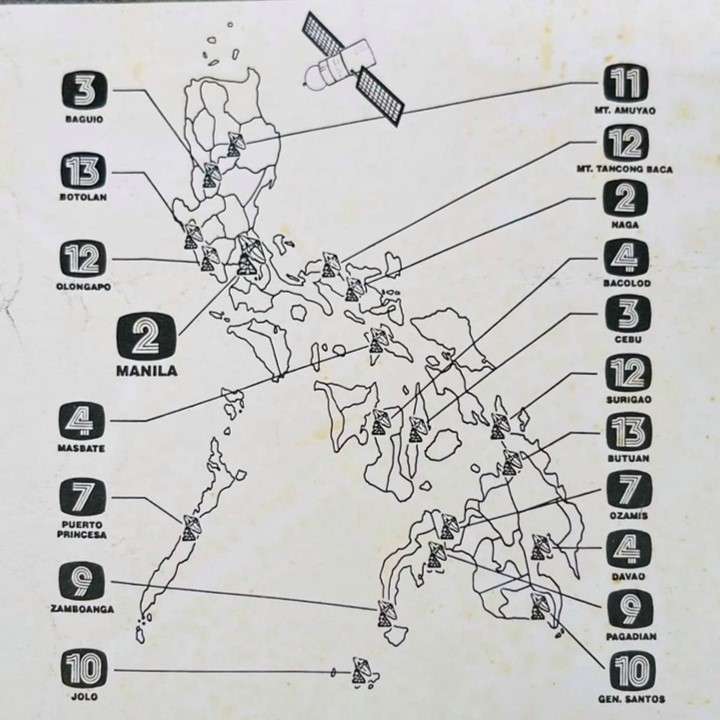



.png)




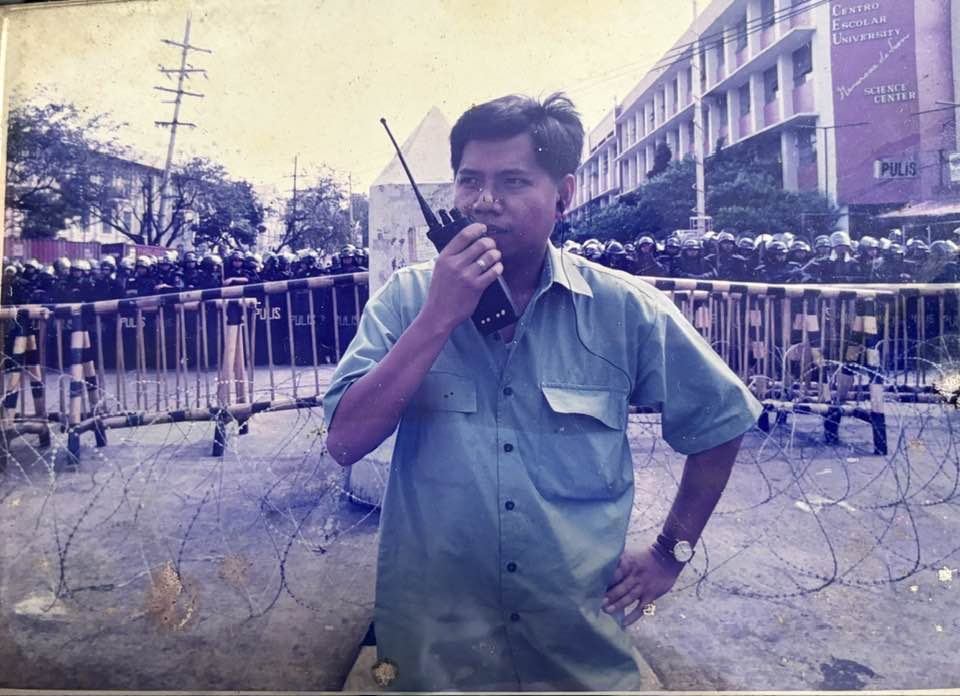







































.jpg)




































































































.jpg)




























%20(1)%20(1).jpg)








.jpg)




































































































































